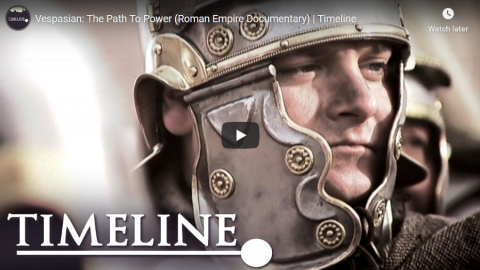Historia Civilis
Published 19 Feb 2015Patreon: https://www.patreon.com/HistoriaCivilis
Website: https://www.historiacivilis.com
Twitter: https://twitter.com/HistoriaCivilisMusic is “Sea” by Jahzzar (http://betterwithmusic.com)
January 25, 2020
Cursus honorum – Praetors
QotD: The post-oil-crisis evolution of modern cars
Man I remember back in 1982, we all thought we’d be driving nothing but 3-cylinder diesels by the turn of the millennium. If you went back and told some gearhead in my high school class that in 2017 Dodge would be selling a “street legal” 10-second Hemi Challenger, he’d think you were talking about the 0-60 time of a 4-cyl car.
The computer changed everything. Not only in engine tuning and performance, but in design and modeling.
I had an example of a classic late Dark Ages car, an ’84 Trans Am with the LG4 305c.i. Rochester Quadrabog motor. A hunnert and fifty horsepower and nearly every engine function powered by enough dry-rotting vacuum tubing to reach to the moon and back…
Only a few years later and exotic computer-designed and controlled long-runner port fuel injection systems were common on domestic performance cars and HP numbers were on the right side of 200 for the first time in a decade.
It was coming out of an awful time. Like a friend wrote: When he went into seminary you could buy a Mustang with a nearly 400bhp engine option. When he left seminary, the Mustang was a Pinto.
Being a car enthusiast in America in the latter half of the 70s/first half of the ’80s was like being a dirt farmer in Fifth Century Britain, marveling at the weed-grown roads and disused aqueducts left by a race of giants and building your pig shed with stones looted from a burned library.
Tamara Keel, “Cars of the future from the past…”, View From The Porch, 2017-12-26.
January 24, 2020
From a Canadian perspective, “NORAD … is more important than NATO”
The American government has once again expressed a strong desire to update the 1957 North American Air Defence Commmand arrangement between the US and Canada for defence of the North American continent. It’s a Cold War relic to some (particularly some in the Prime Minister’s Office and cabinet), but it has a very real value to Canada, as Ted Campbell explains:
In 1957 Canada and the USA agreed to create the North American Air Defense Command. It is a “combined” command, American and Canadian people, civilian and military, work together, in combined headquarters, to conduct an active aerospace defence effort over the continent we share. Americans and Canadians work side-by-side managing the airspace, detecting intruders and identifying and intercepting them and so on.
NORAD, I would argue, is more important than NATO.
First, it is about defending our own homeland.
Second, it is about defending the US strategic deterrent, which has, arguably, done more to keep global peace than all the efforts of the United Nations, combined.
NORAD modernization and expansion should be at the top of Canada’s defence policy agenda. Specifically:
- First, billions of dollars, likely tens of billions of dollars are going to be needed to upgrade the surveillance and warning system. We need new radars, terrestrial and space-based, and upgraded control systems to do the job properly;
- Second, Canada needs to buy enough (85+ is just the very barest of bare minimums) of the right new fighter jet; and
- Third, Canada needs to join the American ballistic missile defence system.
I believe that this issue: the shared defence of our, shared, continent and, therefore, the defence of the American heartland and of America’s strategic deterrent is a key, perhaps even the key element in our most important foreign relationship. […] The knowledge that Canada is doing a full and fair share of defending our shared continent, of defending America, is not lost on admirals and generals, diplomats and senior civil servants, representatives and senators in the US Congress, pundits and political leaders in waiting in the think-tanks and senior staff in the White House, even if Donald J Trump is not impressed … IF we are doing a full and fair share.
Right now, we are not.
“The Attack of the Dead Men” – Gas Warfare on the Eastern Front – Sabaton History 051 [Official]
Sabaton History
Published 23 Jan 2020This episode is about the “Attack of the Dead Men”. During the third battle for Osowiec Fortress in July 1915 during the Great War, German artillery was bombarding the defending Russian soldiers with a new deadly weapon: Poison Gas. The fatal mixture of chlorine and bromine descended like a green fog over the Russian trenches. Without adequate gas-masks to protect themselves, the defenders were believed to all have died in agony. However, as the German infantry advanced, they did not only march right into a Russian counterattack but also encountered the dead, seemingly rising from their graves.
Support Sabaton History on Patreon: https://www.patreon.com/sabatonhistory
Listen to The Great War (where “The Attack of the Dead Men” is featured):
CD: http://nblast.de/SabatonTheGreatWar
Spotify: https://sabat.one/TheGreatWarSpotify
Apple Music: https://sabat.one/TheGreatWarAppleMusic
iTunes: https://sabat.one/TheGreatWarItunes
Amazon: https://sabat.one/TheGreatWarAmazon
Google Play: https://sabat.one/TheGreatWarGooglePlayCheck out the trailer for Sabaton’s new album The Great War right here: https://www.youtube.com/watch?v=HCZP1…
Listen to Sabaton on Spotify: http://smarturl.it/SabatonSpotify
Official Sabaton Merchandise Shop: http://bit.ly/SabatonOfficialShopHosted by: Indy Neidell
Written by: Markus Linke and Indy Neidell
Directed by: Astrid Deinhard and Wieke Kapteijns
Produced by: Pär Sundström, Astrid Deinhard and Spartacus Olsson
Creative Producer: Joram Appel
Executive Producers: Pär Sundström, Joakim Broden, Tomas Sunmo, Indy Neidell, Astrid Deinhard, and Spartacus Olsson
Post-Production Director: Wieke Kapteijns
Edited by: Iryna Dulka
Sound Editing by: Marek Kaminski
Maps by: Eastory – https://www.youtube.com/c/eastoryArchive by: Reuters/Screenocean https://www.screenocean.com
Music by Sabaton.Sources:
– IWM: Q 78100, Q 86635
– The New York Public Library
– Narodowe Archiwum CyfroweAn OnLion Entertainment GmbH and Raging Beaver Publishing AB co-Production.
© Raging Beaver Publishing AB, 2019 – all rights reserved.
“Sorry, Boomers. Just because you’ve been told your entire lives that you’re killing the planet, that doesn’t mean it’s true”
Talk about a golden oldie! Does anyone else remember the portentious “Doomsday Clock”? It was devised shortly after WW2 as a handy visual and rhetorical prop for various unilateral disarmament, Soviet agitprop, and general anti-Western civilization groups to use. It’s apparently still being used to pretend we’re facing yet another potentially world-ending crisis:
Remember the Doomsday Clock? It’s a symbolic clock created by a group of scientists in the 1940s, supposedly indicating how close the human race is getting to Armageddon. Originally the clock was set to seven minutes to midnight, and when the clock strikes 12, we’re all dead. That’s the idea, anyway. This corny propaganda tool reached its pop-culture zenith in the ’80s, when everybody from Midnight Oil and Iron Maiden and Sting to DC Comics’ Watchmen were predicting catastrophe by referencing the Doomsday Clock. People love to be scared about the end of the world, and a lot of artists made a lot of money by exploiting that. Nobody ever lost a buck fearmongering.
But you’re reading this right now, which means we’re all still here. Doomsday hasn’t come. So of course, that must mean … it’s just that much closer!
[…]
And this means as much as it’s meant for the past 70-odd years: nothing. Real clocks are instruments of science; the Doomsday Clock is an instrument of the arbitrary whims of some scientists. It might as well be the Doomsday Dartboard. Do you really think we’re any closer to planetary doom than we were during the Cuban Missile Crisis, or the Chernobyl disaster, or the premiere of MTV’s The Real World? You’ve got all those brainiacs gathered in one place, and not one of them has read “The Boy Who Cried Wolf.”
We scoff at Jim Jones and Marshall Applewhite and other doomsday cult leaders, but at least they had the courage of their convictions. If these scientists really believe we’re all doomed, why are they sticking around? If Al Gore actually believes all hope is lost, why is he still living in huge mansions and jetting off to Davos? As the great Glenn Reynolds says: “I’ll believe it’s a crisis when the people who say it’s a crisis start acting like it’s a crisis.”
The Arms and Armour of The English Civil War
Royal Armouries
Published 21 Dec 2017The Royal Armouries’ English Civil War collection boasts an array of infantry and cavalry arms and armour from the 1640s. Delve into this turbulent historical period with a look at some cavalry arms and armour.
Where to find us:
⚔Website: https://royalarmouries.org/home
⚔Blog: https://blog.royalarmouries.org/
⚔Twitter: https://twitter.com/Royal_ArmouriesThe Royal Armouries is the United Kingdom’s national collection of arms and armour. On this channel, discover what goes on behind the scenes at the museum and to see our collection come to life. From combat demonstrations to jousting coverage to behind the scenes tours with our curators, we’ve got it covered.
Have a question about arms and armour? Feel free to leave us a comment and we’ll do our best to answer it.
QotD: Writing as a career
Leftist writers raised in affluent circumstances — as I think even they would admit, in honest moments — suffer from heroic self-image as an occupational disease. And perhaps this is equally true of the conservatives as well. But when you come from the actual working class — when your father is someone who actually helps assemble buildings, as opposed to designing them — you can never, as a professional intellectual, shake the suspicion that you are going to get caught and sent back to [earn] a proper living. I think it’s part of why relatively minor career crises have such a shattering effect on my nerves; as a columnist I’ve turned out to be much more of a cowardly beggar for editorial reassurance than I ever thought I’d be. It’s because I see my career subconsciously, and always will, as the product of some inchoate power’s inexplicable carelessness.
Colby Cosh “Who let him in?”, ColbyCosh.com, 2005-01-19.
January 23, 2020
Vespasian: The Path To Power | Timeline
Timeline – World History Documentaries
Published 9 Jun 2017Check out our new website for more incredible history documentaries: HD and ad-free. http://bit.ly/2O6zUsK
Looks at the life of the Roman emperor Vespasian, from childhood to his death in 79 AD. Provides insight into the sophisticated workings of the Roman Empire.
Content licensed from Digital Rights Group (DRG).
Pascal’s Wager, environmentalists’ version
Hector Drummond indulges in a proper “Fisking” of a recent column in the Telegraph:
We don’t have to buy into the apocalyptic angst of Greta Thunberg, on show again in Davos yesterday, to recognise that something has to be done.
He actually said “Something Has To Be Done”. How about we do a snow dance, Philip? That’s “something”.
Whether or not you are a sceptic about the impact of CO2 on the climate or question man’s involvement in producing the greenhouse gas, our energy future is a non-carbon one, like it or not.
Our energy future involves a lot of talk about non-carbon energy sources, while relying on “carbon” for a long time to come.
Virtually every government has committed to this as an overt aspect of public policy and those that haven’t, like China or the US, have a rapidly growing green energy sector poised to exploit the move to a carbon‑free future.
You mean the China that’s building coal-fired power plants at a rate of knots? That China?
Later on, the column invokes Pascal’s Wager, which Hector finds both amusing and irritating:
Seriously? Pascal’s Wager, which has been long ridiculed by most scientists and philosophers and thinkers, is now the basis for the largest and riskiest economic and political transformation in human history?
Pascal’s Wager justifies any proposed change in response to any possible threat. It’s possible that all the ducks in the world are really super-intelligent and they’re about to launch a takeover, so we need to kill them all. It’s possible that nylon stockings are eventually going to cause a nuclear explosion. Make your own ones up. The consequences of doing nothing, should these claims turns out to be true, are calamitous. In fact, they’re far more calamitous than most of the possible climate change scenarios.
Proper risk analysis, on the other hand, tells us to look at probabilities of the possible bad outcomes, not just how bad some possible bad outcome would be, were it true. The catastrophic climate change scenarios all have tiny probabilities. Even the IPCC admits that.
[…]
Then we have to look at the costs of the proposed action. The real costs, that is, not just vague claims like “Oh, moving everything to solar energy would be, like, you know, cool, my friend went to this talk once and she said that apparently solar works just as well as coal”. The costs – the real costs – are what needs be weighed against alternative courses of action.
The costs of abandoning fossil fuels are not zero. Not even remotely. Changing to renewables will be massively expensive, destroy jobs, and hinder prosperity, because they cannot provide anywhere near the energy we need. “Generate growth and prosperity” is nonsense, and Johnston should be ashamed of himself for falling for this.
Cut perfect grooves with this DIY tool!
Rex Krueger
Published 22 Jan 2020Make a plane for cutting perfect grooves in wood.
More video and exclusive content: http://www.patreon.com/rexkrueger
Get the Specialty Plane Bundle: https://www.rexkrueger.com/store/spec…
Get the Grooving Plane Plans: https://www.rexkrueger.com/store/plan…Tools in this build (affiliate):
Blue Kreg measuring jig: https://amzn.to/2QTnKYd
Blue Handled Marples Chisels: https://amzn.to/2tVJARY
Suizan Dozuki Handsaw: https://amzn.to/3abRyXB
Vaughan Ryoba Handsaw: https://amzn.to/2GS96M0
Glue Dispenser Bottle: https://amzn.to/30ltwoB
Orange F Clamps: https://amzn.to/2u3tp4X
Blue Painters Tape: https://amzn.to/35V1Bgo
Round-head Protractor: https://amzn.to/37fJ6oz
Nicholson Handy File: https://amzn.to/2NMwrlj
5 Minute Epoxy: https://amzn.to/37lTfjKWood Work for Humans Tool List (affiliate):
Stanley 12-404 Handplane: https://amzn.to/2TjW5mo
Honing Guide: https://amzn.to/2TaJEZM
Green buffing compound: https://amzn.to/2XuUBE2
Cheap metal/plastic hammer for plane adjusting: https://amzn.to/2XyE7Ln
Spade Bits: https://amzn.to/2U5kvML
Metal File: https://amzn.to/2CM985y (I don’t own this one, but it looks good and gets good reviews. DOESN’T NEED A HANDLE)
My favorite file handles: https://amzn.to/2TPNPpr
Block Plane Iron (if you can’t find a used one): https://amzn.to/2I6V1vh
Stanley Marking Knife: https://amzn.to/2Ewrxo3
Mini-Hacksaw: https://amzn.to/2QlJR85Plans, t-shirts, and hoodies: http://www.rexkrueger.com/store
Get my woodturning book: http://www.rexkrueger.com/book
Follow me on Instagram: @rexkrueger
The EU apparently fears a “Singapore on the Thames”
In the Continental Telegraph, Tim Worstall explains why the EU negotiators are reportedly offering a much worse trade deal to the United Kingdom than they’ve already agreed with Canada, Japan, and other trading partners:
Take, for example, this idea of Singapore on Thames. It’s trivially easy to rally the peeps against one or other relaxation of regulation. Chlorine washed chicken for example. But what about lifting the entire burden? Singapore is, after all, about 50% richer than Britain on a per capita basis. The correct question therefore is would you like a 50% pay raise at the price of shooting all the bureaucrats? Given the manner in which the bureaucrats don’t want the question even asked we have a reasonable enough guide that the answer would be yes.
Which is why the terms on offer to a Britain which could do the SonT thing are so terrible. Because of SonT succeeded it would be a death blow to the entire idea of how Europe is regulated. Lille, Leipzig and Livorno will all put up with interfering bureaucracy because that’s just the way the world is. But if Les Rosbifs become richer by half again simply by that bonfire of the regulations then the auto da fes will light up all over Europe.
So, yes, of course the EU is offering shit trade terms. They can’t allow an independent and free Britain to succeed. That we will anyway is what will bring that freedom and liberty to the continent – once again. For as so often it will be us that saves Europe from itself.
Book Review – The Lee Enfield, by Ian Skennerton
Forgotten Weapons
Published 21 May 2017Available from Amazon: http://amzn.to/2qBntgB
Ian Skennerton is a leading authority on British rifles, having written extensively on Sniders, Martinis, Enfields, and more. This specific book, The Lee Enfield is the most recent iteration of his compendium of Lee-Enfield information, printed in 2007 (previous versions were The Lee Enfield Story of the 1980s and The British Service Lee of the 90s). It is an absolute wealth of information, including a large amount of original British military documents. Skennerton covers a huge array of developmental and experimental versions of the Enfield as well as the standard production models (including American, Canadian, Australian, and Indian production).
Strange WW1 modifications and accessories, grenade launchers, snipers, lightweight guns, carbines, long rifles, semiautomatic conversions, you name it — it’s all here. Unfortunately, the organization and editing leaves a lot to be desired, in my opinion. It is a book that looks magnificent when idly flipped through, but can be frustrating to use to understand the history of a gun or guns. The text often jumps from one subject to another, forcing the reader to piece together elements from different sections to figure out a coherent story.
That said, it remains an indispensable book for the Enfield enthusiast, as it has a ton of information not found elsewhere. I hope that if a new revision or edition is ever produced, Mr. Skennerton will employ the services of a ruthless editor to help him form the raw information into a more navigable history.
Cool Forgotten Weapons merchandise! http://shop.bbtv.com/collections/forg…
http://www.patreon.com/ForgottenWeapons
If you enjoy Forgotten Weapons, check out its sister channel, InRangeTV! http://www.youtube.com/InRangeTVShow
















